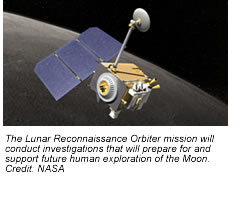

Results showed that temperatures in the shaded, thermally stable areas of the pit only fluctuated by small amounts throughout the lunar day and primarily stayed around the 17° C temperature mark. used computer modeling and data from LRO to analyze the thermal properties of a 100-meter-deep surface pit - known as the Mare Tranquillitatis - and charted the temperature of the pit with respect to time. used data from Diviner to investigate if the temperature inside the pits diverged from temperatures on the lunar surface. (Credit: NASA/Goddard/Arizona State University) The Mare Tranquillitatis pit crater, as imaged by LRO’s Narrow-Angle. “Humans evolved living in caves, and to caves we might return when we live on the Moon,” said co-author David Paige, who leads the Diviner Lunar Radiometer Experiment aboard LRO.

Once all the ejecta re-accreted, the surface of the now-Moon would still have been liquid, meaning that the Moon likely once had massive oceans of molten lava and magma - which would explain the presence of the collapsed lava tubes seen in Horvath et al.’s research. The impact would have been large enough to completely liquefy the ejecta from the impact, which would then have re-accreted into the Moon to create the Earth-Moon system. research have large, visible overhangs that appear to lead to a larger cave system.Ĭurrent theories suggest that the Moon formed from an impact between an ancient Mars-sized planet, named Theia, and a young proto-Earth. Two of the largest and most prominent surface pits seen in the Horvath et al. If the ceiling of one of these subsurface lava tubes becomes unstable, it will collapse and form a pit on the surface, similar to the pits seen on the Moon. Lava tubes can form when either molten lava flows beneath a cooler field of lava or when a crust forms over the top of a river of molten lava.Īs the lava and magma cool, long hollow tunnels are created below the surface. When looking at the nature of the pits and how they formed, Horvath et al.’s research suggest that “about 16 of the more than 200 pits are probably collapsed lava tubes” which formed early on in the Moon’s evolution. In addition to being used as a site for bases that require thermally stable conditions, as the Moon has no atmosphere to protect the surface from solar events and debris, the shaded areas of these pits or caves could be used as shelters to provide protection from intense cosmic rays, solar radiation, and micrometeorites. Knowing that they create a stable thermal environment helps us paint a picture of these unique lunar features and the prospect of one day exploring them,” said LRO Project Scientist Noah Petro of NASA’s Goddard Space Flight Center. “Lunar pits are a fascinating feature on the lunar surface. Surface temperatures on the sunlit side of the Moon can reach to around 127° C, with night-side temperatures reaching as low as -173° C.

(Credit: NASA/GSFC/Arizona State University) These images, taken by LRO, show the Marius Hills pit, which is approximately 34 meters deep. Understanding the temperatures of these pits is important for future exploration of the Moon, as they could be used for future sites or bases that require thermally stable (neither extremely hot nor extremely cold) locations. Lunar surface pits were first seen in 2009, and since their discovery, scientists have theorized that the pits serve as openings to underground caves and other subsurface geologic features. research shows that the temperature of the pits stays around 17° Celsius (63° Fahrenheit) in shaded areas. Since inserting into lunar orbit on June 23, 2009, LRO has imaged, investigated, and measured the lunar surface pits that are the subject of new research led by Tyler Horvath, a student at the University of California, Los Angeles. Using data from NASA’s Lunar Reconnaissance Orbiter (LRO), a group of NASA-funded researchers has discovered that shaded locations inside surface pits on the lunar surface harbor comfortable temperatures that could prove useful for future lunar exploration.įurthermore, LRO continues to operate in a healthy state around the Moon and is regularly returning data, so much so that NASA awarded the spacecraft and teams a mission extension back in April, which will allow the craft to continue its observations of the Moon.


 0 kommentar(er)
0 kommentar(er)
